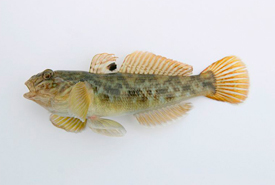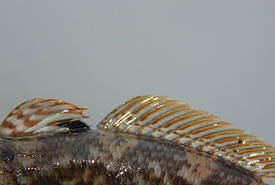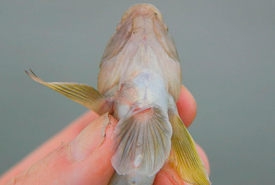Something's Fishy: The good, the bad and the goby

Round goby (Photo by Peter van der Sluijs/Wikimedia Commons)
Think of the meanest, toughest fish in a Canadian river. The one other species actively avoid, swimming faster as it approaches. Is it the longnose gar, with its mouth full of sharp teeth? Or the largemouth bass, a species which devours its prey in one swift gulp?
Think again. The species that has fish, and the scientists who study them, worried is the invasive round goby. Coming in at a whopping eight to 12 centimetres, this aggressive, bottom-dwelling fish has already wiped out a significant portion of mottled sculpin populations in Canadian waters.
Unfortunately many native sculpin species are mistaken for round gobies. The first time I saw one of these buggers I thought it was a member of the Cottus family, due to its flattened head. Much to my dismay, this was an imposter!
The most distinctive features of an adult round goby is the prominent black spot located at the end of the first dorsal fin. Unlike the sculpin, its body is fully scaled. Reproducing males will ditch the usual

The dorsal fins of a round goby (Photo by Peter van der Sluijs/Wikimedia Commons)
brownish/olive scales and brown spots to sport almost completely black fins and body. Another idiosyncratic feature of the round goby is the fused scallop-shaped pelvic fin on its belly.
Now that we’ve captured the mugshot of this freshwater criminal, let’s look at its felonious rap sheet. The round goby’s aggressive behaviour and rapid reproduction have critically impacted native fish species. It has similar niches as other bottom-dwelling fish, competing with and preying on species such as sculpin and logperch. Gobies also threaten many at-risk species in the Great Lake Basin in Ontario, including northern madtom, eastern sand darter and several freshwater mussel species.
The round goby is able to out-compete similar species due to its capability to rapidly reproduce. They have an extended reproductive season and the ability to spawn several times in this duration. This aggressive spawning ritual provides the potential for round gobies to have a large number of offspring in a year.
The round goby isn’t just picking on species its own size. This species is responsible for reducing populations of sport and commercial fish by competing for similar food sources and consuming the eggs and young of species such as the lake trout and sturgeon.
The only plus side to this unwanted species is that its main source of food is just as unwelcome in Canadian waters as it is. It has been found that the hard substrates where round gobies are found house the largest part of its diet: zebra mussels.

Two fused pelvic fins create a suction cup on the belly of round goby (Photo by Peter van der Sluijs/Wikimedia Commons)
But don’t get too excited. Despite the potential upsides, this allows the round goby to wreak havoc outside of the water. Researchers believe this species is linked to outbreaks of the toxin Type E Botulism. This bacteria is a form of lethal food poisoning that can infect waterfowl species such as gulls, ducks and cormorants, restricting mobility, preventing them from flying or holding their head up. This unfortunately can cause the infected bird to drown. This toxin is may be passed when an infected zebra mussel is consumed by round goby, then the infected goby is consumed by a bird.
The round goby is known to exist in all five Great Lakes, spreading to the rivers and tributaries connected to them. Many Nature Conservancy of Canada properties, including Happy Valley Forest in King City, ON, contain streams, lakes or ponds within these watersheds.
In Ontario, the government has combatted the spread of the species by prohibiting the domestic possession of live round goby and the use of the species as a baitfish.
Off-shore fishing is permitted on the Happy Valley Forest property and several other NCC-conserved lands, such as Elbow Lake and Minesing Wetlands.
As with all provincial waters, Ontario fishing by-laws are enforced. By following these guidelines, you can help prevent the spread of gobies, allowing the native fish species in NCC protected waters to flourish.
Something’s Fishy is a monthly series written by NCC’s Communications Assistant, Raechel Bonomo, highlighting a species or group of fishes that inhabitant Canadian waters.


